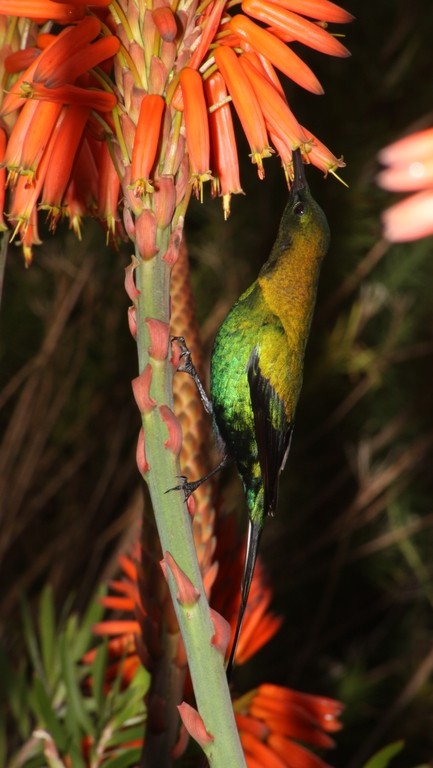Malachite Sunbird
A species of African Long-tailed Sunbirds Scientific name : Nectarinia famosa Genus : African Long-tailed Sunbirds
Malachite Sunbird, A species of African Long-tailed Sunbirds
Botanical name: Nectarinia famosa
Genus: African Long-tailed Sunbirds
Content
Description General Info
Description
The breeding male malachite sunbird, which has very long central tail feathers, is 25 cm long, and the shorter-tailed female 15 cm. The adult male is metallic green when breeding, with blackish-green wings with small yellow pectoral patches. In non-breeding (eclipse) plumage, the male's upperparts are brown apart from the green wings and tail, the latter retaining the elongated feathers. The underparts in eclipse plumage are yellow, flecked with green. The female has brown upperparts and dull yellow underparts with some indistinct streaking on the breast. Her tail is square-ended. The juvenile resembles the female. 
Size
13 - 27 cm
Nest Placement
Tree
Feeding Habits
Malachite Sunbird primarily consumes nectar and insects, along with occasional small lizards. It feeds from a variety of plants like aloes and red-hot pokers, foraging alone or in groups. Unique adaptations include pollination while feeding, particularly on specialized plants like the rat’s-tail.
Habitat
Malachite Sunbird thrive mainly in fynbos with protea, montane and coastal scrubs, and diverse high-altitude areas up to 2,800 meters, extending from the Ethiopian highlands to sea level regions in South Africa. These birds adapt well to both natural environments, such as hilly aloe-rich regions, and man-made settings like parks. Habitats with abundant flowering plants essential for their nectar diet are preferred.
Dite type
Nectivorous
General Info
Feeding Habits
Bird food type
Behavior
This species is monogamous. The oval nest is usually suspended, as with most sunbirds, or constructed inside a bush. The female incubates one to three dark-blotched, greenish eggs for two weeks. The chicks are fed by both parents until fledging time, and the chicks will for a time return to the nest to roost. The malachite sunbird is often double-brooded, and may be parasitised by Klaas's cuckoo or red-chested cuckoo. It is territorial and aggressive when nesting, but highly gregarious when not breeding, forming flocks of over 1,000 birds. The call is a loud tseep-tseep, and the male malachite sunbird has a twittering song, often accompanied by pointing its head upward and displaying his yellow pectoral tufts with his wings half open. Males also have an elaborate display flight. It was found that male birds display their pectoral tufts almost continuously throughout the night, whilst asleep, and one hypothesis is that these function as eyespots to deter nocturnal predators. 
Species Status
Not globally threatened.
Scientific Classification
Phylum
Chordates Class
Birds Order
Perching birds Family
Sunbirds and spiderhunters Species
Malachite Sunbird 